“Murder in the Pacific” (three part series) BBC iPlayer
This three-part BBC documentary, “Murder in the Pacific,” provides a comprehensive exploration of the tragic events surrounding the sinking of the Rainbow Warrior. Part one of the series delves into the work of Greenpeace and the crew of the ship, providing context and insights into the events that led up to the devastating attack. Part two offers a deep dive into the police investigation and the efforts to bring those responsible for the attack to justice. Finally, part three examines the planning of the attack by French secret services, the diplomatic fallout from the bombing, and the impact it had on international relations between France and New Zealand.
This powerful series offers a compelling account of the devastating consequences of state-sponsored terrorism and the courage and resilience of those who fought for environmental justice in the face of violent opposition.
Built like a tank
The documentary begins by detailing the commissioning of the Rainbow Warrior. Originally an ageing North Sea fishing trawler, the vessel was refitted with sails and transformed into Greenpeace’s flagship vessel. Through archive photographs and interviews with Second Mate Bunny McDiarmid and Skipper Peter Wilcox, the documentary offers a glimpse into the camaraderie shared among the crew. The crew was comprised of individuals from various nations, including the United States, France, Portugal, and the UK, with over half of the crew hailing from New Zealand. It is clear from the documentary that the crew members were a group of dedicated activists, many of whom were young and passionate about the environmental issues they were fighting for.
“1985 was our year of protesting nuclear testing in the Pacific, we were eager to go out and try to change the world to some place better”.
Peter Wilcox, Skipper, Rainbow Warrior
“Built like a tank” and the perfect boat to send out “a bunch of crazy hippies out with in the ocean,” Wilcox vividly describes the Rainbow Warrior. He fondly recalls the vessel as a place of “good energy,” where the crew was united by their passion for environmental activism and driven by a shared sense of purpose. The skipper’s words offer a unique glimpse into the special bond shared by the crew members aboard the Rainbow Warrior and their unwavering commitment to making a positive impact on the world.
The first job for the new crew was the relocation of the inhabitants of Rongelap Atoll. The inhabitants of Rongelap Atoll were exposed to high levels of radiation due to nuclear testing by the United States in the 1950s. Between 1946 and 1958, the US conducted 67 nuclear tests in the Marshall Islands, including the testing of the world’s first hydrogen bomb on Bikini Atoll in 1952. The testing released massive amounts of radioactive material into the atmosphere, and the winds carried the fallout to surrounding atolls, including Rongelap Atoll. The islanders were not warned of the dangers of radiation and continued to drink contaminated water and eat contaminated food, resulting in widespread radiation poisoning. The legacy of US nuclear testing in the Marshall Islands continues to have a devastating impact on the health and wellbeing of islanders to this day.
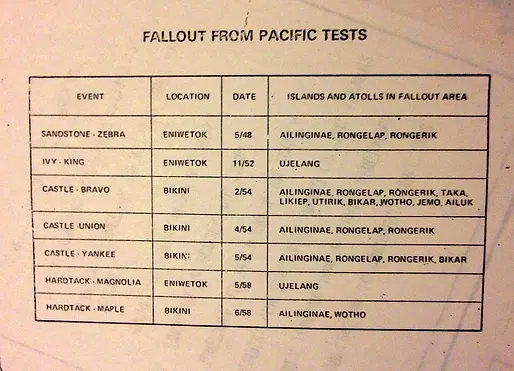
In the early 1980s, Greenpeace became aware of the catastrophic impact of US nuclear testing on the people of Rongelap Atoll. The islanders had been exposed to extremely high levels of radiation, which had led to the development of a host of health problems and birth defects. The inhabitants of Rongelap Atoll were tragically forced to endure the devastating effects of nuclear fallout, essentially serving as involuntary test subjects.
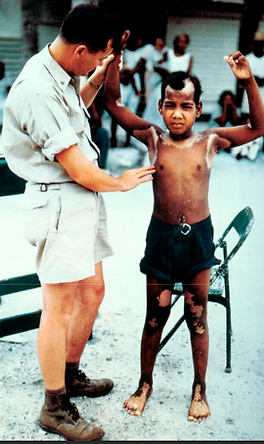
Greenpeace launched a campaign for the relocation of the islanders and raised international awareness through protests and direct actions. In May 1985, Greenpeace worked with the Marshallese government and the crew of the Rainbow Warrior to transport the islanders to Ailinginae Atoll, an uninhabited island about 100 miles away from Rongelap.
The organisation also provided medical assistance and continued to advocate for compensation for those who suffered from radiation exposure. The documentary includes archive footage of the crew moving the islanders’ broken-down homes to be rebuilt on the new atoll. The devastating effects of radiation are also shown, with harrowing footage of children born with severe birth defects, including the account of one mother whose child was born with no bones. Greenpeace’s work in Rongelap Atoll highlighted the organisation’s commitment to environmental justice and protecting vulnerable communities from the harmful effects of environmental degradation and nuclear testing.
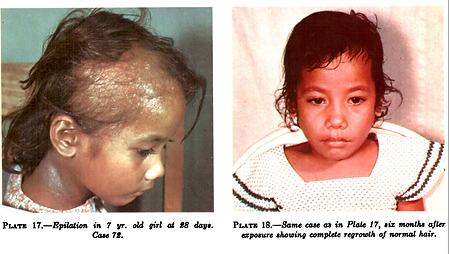
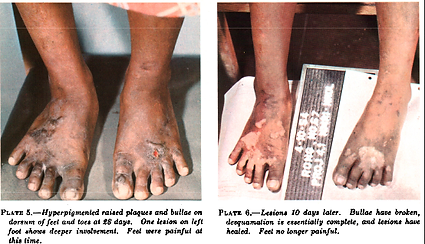
The devastating effects of radiation are also shown, with harrowing footage of children born with severe birth defects, including the account of one mother whose child was born with no bones.
Stop the French
When it was sunk, the ship was getting ready to lead a protest against French nuclear testing in the Pacific. At the time, Greenpeace was known for its direct-action campaigns throughout the 1980s. These campaigns aimed to raise awareness about environmental issues and force governments and corporations to take action. The campaigns often involved peaceful protests and civil disobedience, such as boarding ships and occupying buildings. The protest against the French government’s nuclear testing was to be another such action.
The Rainbow Warrior was not just Greenpeace’s flagship, but also a powerful symbol of hope and progress for the organisation. As the focal point for ocean campaigning, it embodied the ideals and aspirations of the movement. As Bunny McDiarmid, a Greenpeace activist and crew member, stated in an interview with The Guardian:
“To see it destroyed in such a violent and senseless way was a devastating blow to all of us.”
Bunny McDiarmid, Second Mate, Rainbow Warrior
The bombing of the Rainbow Warrior was proved to be an act of state-sponsored terrorism carried out by agents of the French intelligence agency, the DGSE. Initially, French authorities denied involvement, but after an intensive investigation by the New Zealand police and later reporting by some tenacious French journalists, the truth was eventually uncovered. The attack resulted in the death of one crew member, Fernando Pereira, and the sinking of the vessel. The incident caused international outrage and strained diplomatic relations between New Zealand and France.
Hear radio coverage of the sinking of the Rainbow Warrior in 1985.
Man: Somebody blew up our boat. They ripped her guts out and killed one of our crew. I feel like someone had ripped some of my guts out in the process. I and the rest of Greenpeace will not rest until she or her successor is sailing again.
Second man: Well I just lost a good friend, and now I have to go to the morgue to identify him, so I guess that says it.
Female announcer: Explosions rang out from the 40-metre ship at around midnight and the crew scrambled to get off the vessel to safety as she began going under, but one crew member was caught below decks, and police recovered his body this morning. Stunned Greenpeace people say the vessel was priceless, but right now they are still mourning for their dead colleague who went down with the vessel.
Man: All we know is that between the first and second explosions he went back on board, presumably to retrieve his camera gear, and he never made it out.
Male announcer : Rainbow Warrior didn’t go to a warrior’s death; she sank in her sleep just after midnight, tied up at an Auckland wharf. It’s a tragic end to what was probably the world’s number one peace vessel, small as she was. In recent months, Rainbow Warrior has plied from Pacific island to Pacific island, moving people from the ravages of the troubled years we live in. What blew her up and killed a man of peace?
Man: I’d say half of the world leaders of Greenpeace are in New Zealand at the moment.
Interviewer: So the one big question mark in your mind at the moment is?
Man: Is, what happened on the boat last night? Is it an accident, or was it not an accident?
Fernando Pereira was a photographer and crew member aboard the Rainbow Warrior when it was bombed in Auckland Harbour on July 10, 1985. He was a Dutch citizen of Portuguese descent and was just 35 years old when he lost his life in the attack. Pereira was known for his skill as a photographer and his passion for environmental activism. He had been with Greenpeace for several years and had travelled the world documenting the organization’s campaigns and protests.
On the night of the attack, Pereira was below deck when the bombs went off. He was most likely going to grab some of his equipment and make his way up to the deck when the second explosion went off, but he was unable to get off the ship before it sank. Witnesses on board describe the ship sinking in about 40 seconds. His body was found in his cabin the next day, and he was later identified by his dental records. Pereira’s death was a devastating blow to his family and colleagues, and it highlighted the risks that environmental activists face in their work. The fact that more of the ship’s crew were not killed was purely a matter of chance. Pereira’s death also underscored the importance of the work that Greenpeace and other organisations do to protect the environment and hold governments and corporations accountable for their actions.
“The goal was not to slaughter people. I might be seen as a killer or an assassin, but the truth, it’s pretty complicated.”
Jean-Luc Kister, former French Special Forces
Denial
The French government initially denied any involvement, but it later emerged that the decision to carry out the bombing was made at the highest levels of the French government. The French government’s motivation for the attack was its desire to prevent Greenpeace from interfering with its nuclear testing program in the Pacific. At the time, the French government was carrying out a series of nuclear tests on the atolls of Mururoa and Fangataufa, despite widespread opposition from environmental groups and Pacific Island nations.
Greenpeace was viewed by the French government as a threat to its nuclear testing programme, and it was believed that the Rainbow Warrior’s planned protest would disrupt its operations. The attack on the Rainbow Warrior was therefore a clear example of state-sponsored terrorism, carried out in the interests of a government that was willing to use violence to protect its own interests. The aftermath of the bombing was a complex and messy affair, with allegations of government cover-ups and attempts to downplay the severity of the attack. The French government initially denied any involvement, but later admitted responsibility and paid compensation to Greenpeace and the family of Fernando Pereira.
The attack on the Rainbow Warrior was therefore a clear example of state-sponsored terrorism, carried out in the interests of a government that was willing to use violence to protect its own interests.
“The truth about what happened that night needed to come out, and justice needed to be served,” said McDiarmid in an interview with The Guardian. “The fact that the French government tried to cover up their involvement only made us more determined to continue our work and fight for a better world.”
During the third part of the documentary, Jean-Luc Kister, one of the bombers, is interviewed and expresses his bewilderment at the decision to attack Greenpeace. Before the mission, he admits to thinking:
“but why Greenpeace? Targeting a pacifist movement in such a violent way. Am I serving my country? Am I serving the interests of France?”
Jean-Luc Kister, former French Special Forces
Kister goes on to explain that the French government had told them that Greenpeace had been infiltrated by the KGB, and behind them was the Soviet Union, making them a potential threat to national security. This wasn’t the first time such an accusation had been made in this series, with Michael Heseltine, the then UK government defence secretary, stating that he was certain there were “people who were sympathisers with the communist cause” in reference to the Campaign for Nuclear Disarmament (CND). Malcolm Rifkind, who worked with Heseltine as a junior minister in the foreign office of the Thatcher government, was asked if the KGB might have infiltrated Greenpeace. In response, he suggested, “They could very well have been.” Given this incident, one might question whether those who worked for Greenpeace were viewed as legitimate targets or mere collateral damage.
“So we accepted the mission.”
Jean-Luc Kister, former French Special Forces
There is no concrete evidence that Greenpeace was infiltrated by the KGB during the 1980s. The French government and some members of the British government have made accusations, but there isn’t much evidence to back them up. Experts and scholars have largely ignored these claims. Greenpeace has consistently denied any allegations of espionage or infiltration, and there has been no proof to suggest that the organisation had any ties to the KGB or any other intelligence agency.
As part of their investigation, the French authorities initially denied that the Rainbow Warrior was targeted for destruction. Instead, they claimed that the agents intended only to damage the vessel’s propellers, making it unable to sail. However, this explanation was met with scepticism, and many believed that the French government had deliberately misled the public to downplay the severity of the attack.
“We made up a story, a fable.”
Pierre Joxe, Minister of the Interior, 1984, 85
The French Watergate
The Le Monde newspaper investigation was a significant development in the Rainbow Warrior bombing case. After the attack, French authorities denied any involvement and claimed that the bombing was carried out by terrorists. However, in 1986, the French newspaper published its investigative report that revealed the involvement of French intelligence services in the attack. The report identified several members of the intelligence service who were involved in the bombing, including Dominique Prieur and Alain Mafart.

It provided concrete evidence of French involvement in the attack and contradicted the official French government version of events. The publication of the report put pressure on the French government to acknowledge its role in the bombing and to take responsibility for its actions. The revelation of French involvement in the attack strained relations between France and New Zealand, and it took several years for the two countries to repair their diplomatic ties.
“The Rainbow Warrior attack was a total operation of the French State”.
Edwy Plenel, French Political Journalist Le Monde
Le Canard enchaîné, a French satirical newspaper, also played a significant role in uncovering the truth about the Rainbow Warrior bombing. In the aftermath of the attack, the French government denied any involvement and claimed that the bombing was carried out by terrorists. However, Le Canard enchaîné working with Le Monde published a series of articles that challenged the government’s version of events using a highly placed source within the state apparatus and suggested that French intelligence may have been involved in the attack.
“the source is the journalist’s treasure.”
Edwy Plenel, French Political Journalist le monde
Le Canard enchaîné published leaked documents and interviews with sources within the French government and intelligence services that contradicted the official version of events. The newspaper’s reporting helped to create public pressure for the government to acknowledge its role in the bombing and to take responsibility for its actions.
“and that’s where the house of cards falls”.
Edwy Plenel, French Political Journalist Le Monde
“Hernu, who was the Minister of Defence, said “it’s a scandal! It’s not truth. I’m going to sue Le Monde”.
Rémi Parmentier, French Political Journalist Le Canard enchaîné
The Le Monde and Le Canard enchaîné investigations can be viewed as critical turning point in the Rainbow Warrior bombing case. Both provided vital information about the attack and forced the French government to confront its role in the bombing. Following the Rainbow Warrior bombing, both Defence Minister Charles Hernu and Admiral Lacoste, who ran the French secret services, resigned from their positions. As journalist Edwy Plenel comments in the documentary, both resignations were “about protecting the President from any questions.” It is unclear whether Hernu or Lacoste informed President Mitterand about the operation. As one of the journalists involved in the case notes, France is not “a banana republic; it is impossible for the secret service to decide on an operation without having a green light from the highest authority.” The work of the journalists demonstrates the power of independent media to challenge official narratives and expose the truth.
“That a first world government had set out to stop us waving some flags felt bizarre”.
Peter Wilcox, Skipper, Rainbow Warrior
As one of the journalists involved in the case notes, France is not “a banana republic, it is impossible for the secret service to decide on an operation, without having a green light from the highest authority.”
Arrests
A total of 12 people were implicated in the bombing, including members of the French intelligence service and their local support team in New Zealand. The two French agents who were arrested and charged for their involvement in the attack were Dominique Prieur and Alain Mafart. While in prison awaiting trial, there was a report that the French may try and break them out of prison, which resulted in Dominique Prieur being moved to a military prison! They were part of the larger team of French agents sent to New Zealand to carry out the attack, and they were initially charged with murder. But later, the charges were changed to “manslaughter,” and the trial only took ten minutes. Both were sentenced to ten years in prison.
“French spies and terrorism, stuff like this just doesn’t happen in New Zealand”.
New Zealand Police officer
“From a French perspective they are not criminals, they were soldiers who obeyed orders”.
Pierre Joxe, Minister of the Interior, 1984, 85
“I don’t care if you are military, you have a responsibility for the actions you take, you can’t just say you have to follow orders. Sometimes those orders are wrong.
Bunny McDiarmid, Second Mate, Rainbow Warrior
Jean-Luc Kister, the head of the French intelligence service’s action division, was also implicated in the Rainbow Warrior bombing. He was allegedly responsible for planning the attack, but he was never arrested or charged in connection with the bombing. Kister was covered by diplomatic immunity, which prevented him from being extradited to New Zealand to face charges.
In a 2005 interview with New Zealand journalist Selwyn Manning, Kister admitted to being involved in the planning of the attack but denied any direct involvement in the bombing itself. Despite Kister’s admission, he was never prosecuted for his role in the attack.
The documentary reveals Kister’s actual involvement in the attack. While he expresses remorse for his actions today, it appears that his regret primarily arises from the fact that he had a newly born child at the time of the attack and discovered that the victim, Pereira, also had a young family. This revelation may have caused Kister to reflect on the impact of his actions, not just on himself but also on the victim’s family. The similarity in their situations—both having young families—may have made Kister more empathetic towards Pereira’s family and the profound loss they experienced due to his actions.
Economic Pressure
However, in a controversial move, the French government pressured the New Zealand government to release the agents after just two years, as part of a diplomatic agreement between the two countries. Dominique Prieur and Alain Mafart were both transferred to a French military base on Hao Atoll in French Polynesia and then released to a hero’s welcome back in France. This led to widespread condemnation of the French government and strained relations between France and New Zealand for many years.
“They were people who had obeyed stupid orders, so we had to get them out…Yes there was economic pressures on imports of certain products”.
Pierre Joxe, Minister of the Interior, 1984, 85
Following the 1985 bombing, France and New Zealand reached a settlement agreement in 1987. This agreement included a formal apology by France, compensation to the New Zealand government for damage to its reputation, and compensation to Greenpeace for the loss of the ship and the death of a crew member. The compensation to Greenpeace included a payment of $8.16 million (NZD) and the purchase of a new ship, the Rainbow Warrior II. In 1998, France and Greenpeace reached a separate settlement agreement, in which France agreed to pay an additional $6.5 million (USD) in compensation to Greenpeace. This settlement also included an agreement by Greenpeace to drop all legal claims against France related to the bombing. While the 1987 settlement compensated the victims of the attack, including the survivors who were injured, there is no record of France directly apologising to them. The French government has never apologised to the crew of the Rainbow Warrior.
” Despite the efforts of New Zealand police no other persons suspected of being involved in the bombing was ever charged or extradited”.
Murder in the Pacific, BBC documentary
Despite the setback caused by the bombing, Greenpeace remained committed to its mission, and the legacy of the Rainbow Warrior continues to inspire environmental activists to this day. The incident also brought attention to the issue of French nuclear testing in the Pacific, which ultimately led to a global ban on nuclear weapons testing. The Rainbow Warrior became a symbol of the power of peaceful protest and the importance of environmental activism.
Watching the original Rainbow Warrior being laid to rest in Matauri Bay, North Island, New Zealand, where it was deliberately sunk to create an artificial reef, was a powerful conclusion to this series.
The ship now serves as a memorial to the environmental activism it represented, and is a popular dive site.
“it feels really right that she is there”.
Bunny McDiarmid, Second Mate, Rainbow Warrior
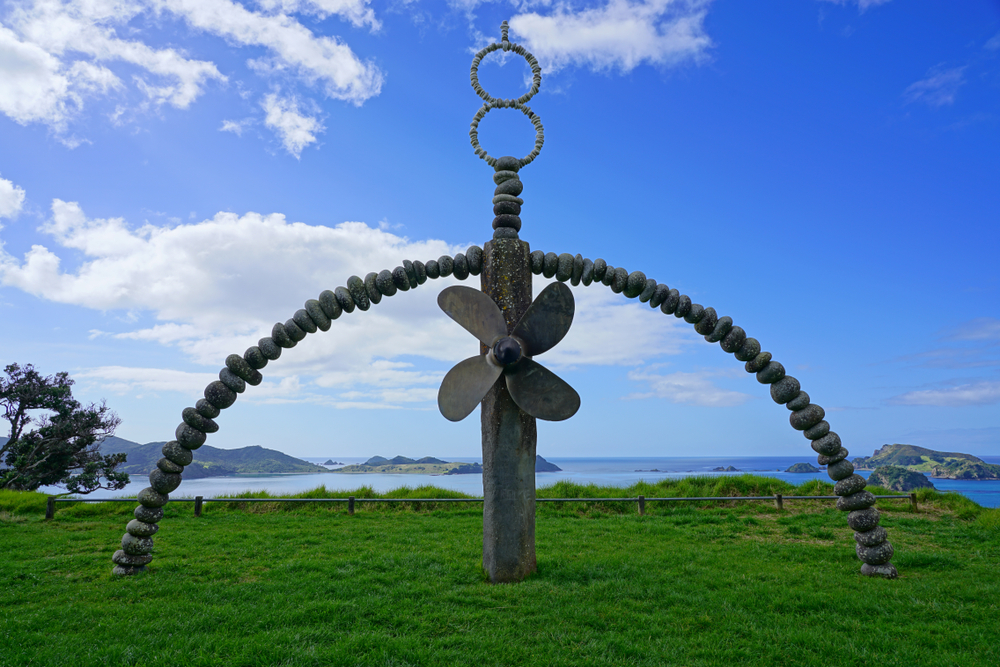
Legacy
The bombing of the Rainbow Warrior was a tragic event that had a profound impact on Greenpeace and the broader environmental movement. The attack demonstrated the lengths to which governments are willing to go to protect their interests and the importance of peaceful activism in the face of violence and oppression. The legacy of the Rainbow Warrior serves as a reminder of the ongoing struggle for environmental justice and the need for continued action to protect the planet and its inhabitants. In the years since his death, Pereira has been remembered as a dedicated and passionate advocate for environmental justice. His legacy lives on in the ongoing work of Greenpeace and other organisations that continue to fight for a cleaner, more sustainable future.
The attack demonstrated the lengths to which governments are willing to go to protect their interests and the importance of peaceful activism in the face of violence and oppression.
In the aftermath of the bombing, Greenpeace replaced the original Rainbow Warrior with a new vessel, which was launched in 1989. The new Rainbow Warrior II continues to carry out environmental campaigns to this day, and it has become an iconic symbol of the environmental movement.
The documentary series is a powerful and compelling watch that showcases the passion and dedication of Greenpeace activists, such as Bunny McDiarmid and Peter Wilcox. It also sheds light on the extreme measures that states will take to protect their military power and the devastating impact that acts of state-sponsored terrorism can have on the lives of those involved. The continued emotional toll of Fernando Pereira’s death on his former crew members, even years later, serves as a poignant reminder of this tragedy. RIP Fernando Pereira.
Art Book Review Books Capitalism China Climate Emergency Conservative Government Conservative Party COVID-19 Creeping Fascism Economics EcoSocialism Elections Europe Event Video Far-Right Fascism Film Film Review France Gaza Global Police State History Imperialism Israel Italy Keir Starmer Labour Party London Long Read Marxism Marxist Theory Migrants NATO Palestine pandemic Protest Russia Solidarity Statement Trade Unionism Trans*Mission Ukraine United States of America War

